松果腺或骨骺,是大多数脊椎动物大脑中的一个小内分泌腺。松果腺产生褪黑激素,一种5-羟色胺衍生的激素,可调节昼夜节律和季节性周期的睡眠模式。腺体的形状类似于一个松树锥体,它的名字来源于它。[1]松果腺位于大脑中央附近的上丘脑中,位于两个半球之间,隐藏在沟槽的两半处。[2] [3]松果体是神经内分泌分泌的周围器官之一,不属于血脑屏障。[4]
几乎所有脊椎动物都拥有松果体。最重要的例外是原始脊椎动物,盲鳗。然而,即使在盲鳗中,背侧间脑也可能存在“松果体等效”结构。[5]梭状芽孢杆菌(Branchiostoma lanceolatum),相对于脊椎动物最近存在,也缺乏可识别的松果腺。[6]但是,七鳃鳗(另一种原始脊椎动物)确实拥有一种。[6]一些更发达的脊椎动物在其进化过程中失去了松果体。[7]
进化生物学,比较神经解剖学和神经生理学的各种科学研究结果解释了不同脊椎动物物种松果腺的系统发育。从生物进化的角度来看,松果腺代表一种萎缩的光感受器。在一些两栖动物和爬行动物的外阴下,它与一个被称为顶叶的光敏器官相连,它也被称为松果体眼或第三只眼。[8]
RenéDescartes认为人类松果腺是“灵魂的主要位置”。他同时代人的学术哲学认为松果腺是一种没有特殊形而上学特质的神经解剖结构;科学研究它作为许多人的内分泌腺体。
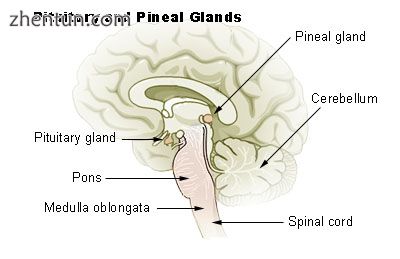
人脑垂体和松果体图
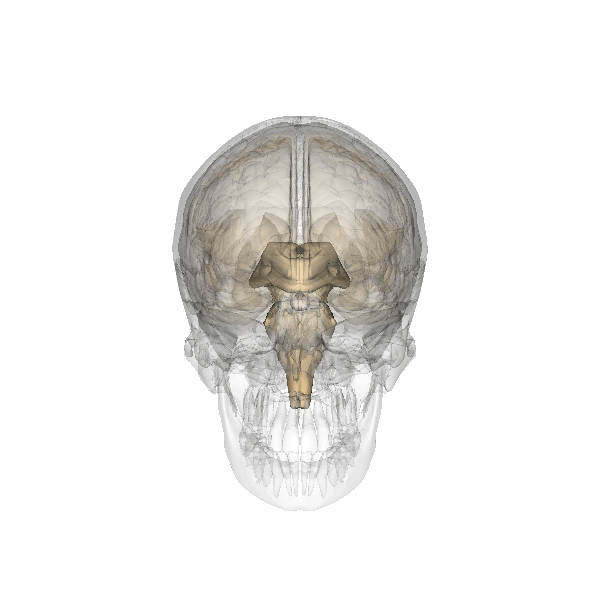
松果体或骨骺(大脑后部呈红色)。将图像展开为动画版本
目录
1 词源
2 结构
2.1 血液供应
2.2 神经供应
2.3 显微解剖
2.4 发育
2.5 对称
3 功能
3.1 脑下垂体的调节
3.2 药物代谢
3.3 骨代谢调节
4 临床意义
4.1 钙化
4.2 肿瘤
5 其他动物
6 社会和文化
7 历史记录
8 另见
9 其他图像
10 参考
词源
来自拉丁松果(松果)的松果这个词在17世纪晚期首次用于指代脑腺的锥形。[1]
结构体
松果腺是中线脑结构,未配对。它的名字来自它的松锥形状。[1] [9]腺体呈红灰色,大约是人类大米(5-8毫米)的大小。松果腺,也称为松果体,是上丘脑的一部分,位于横向定位的丘脑体之间和缰骨合缝体后面。它位于四边形蓄水池附近的四边形蓄水池中。[10]它也位于第三脑室后面,沐浴在通过第三脑室小松果体凹陷供应的脑脊液中,该凹陷伸入腺体的柄部。[11]
血液供应
与大多数哺乳动物的大脑不同,松果腺不是通过血脑屏障系统从体内分离出来的; [12]它具有丰富的血流,仅次于肾,[13]从后部的脉络膜分支提供脑动脉。
神经供应
松果腺从上颈神经节接受交感神经支配。也存在来自翼腭和耳神经节的副交感神经支配。[14]此外,一些神经纤维通过松果体柄(中央神经支配)渗入松果腺。此外,三叉神经节中的神经元通过含有神经肽PACAP的神经纤维支配腺体。
显微解剖
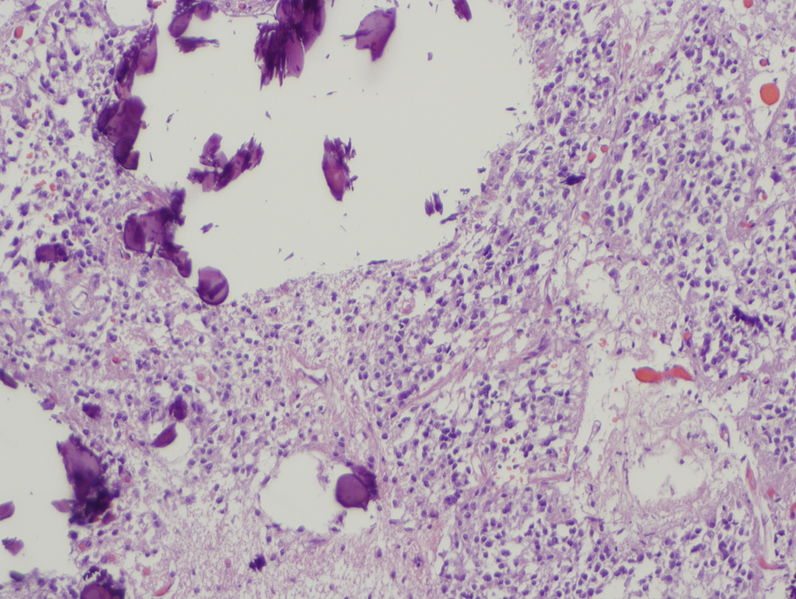
松果腺实质与钙化。
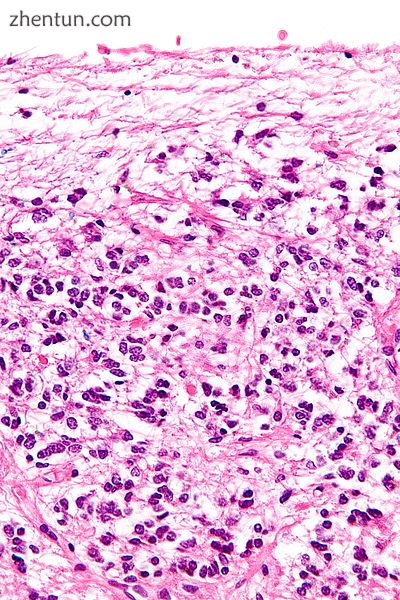
正常松果腺的显微照片 - 非常高的放大率。
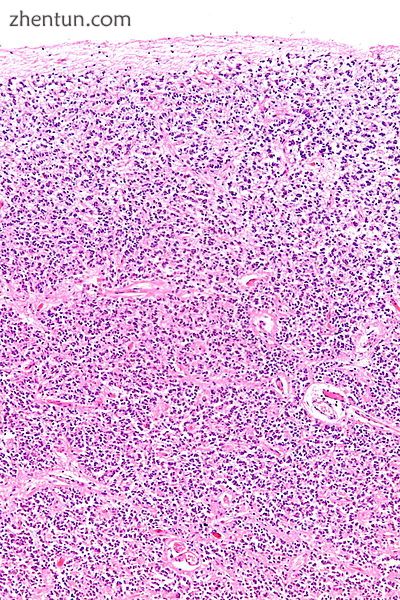
正常松果腺的显微照片 - 中间放大倍数。
松果体包含由结缔组织空间包围的松果体细胞的小叶薄壁组织。腺体的表面被一个软膜囊盖住。
松果腺主要由松果体细胞组成,但已鉴定出其他四种细胞类型。因为它是相当细胞的(相对于皮质和白质),它可能被误认为是一种肿瘤。[15]
细胞类型描述
多肽神经元样细胞在一些物种中,存在神经元样肽能细胞。这些细胞可能具有旁分泌调节功能。
发展
人类松果体的大小一直持续到大约1-2岁,此后保持稳定,[16] [17]虽然它的体重从青春期开始逐渐增加[18] [19]。据信,儿童中丰富的褪黑激素水平会抑制性发育,松果体肿瘤与性早熟有关。当青春期到来时,褪黑激素的产生减少。[20]
对称
在斑马鱼中,松果体不会跨越中线,但表现出左侧偏见。在人类中,功能性脑优势伴随着微妙的解剖学不对称。[21] [22] [23]
功能
松果体的主要功能是产生褪黑激素。褪黑激素在中枢神经系统中具有多种功能,其中最重要的是帮助调节睡眠模式。褪黑激素的产生受到黑暗的刺激并被光抑制。[24] [25]视网膜中的光敏神经细胞检测光并将该信号发送到视交叉上核(SCN),使SCN与昼夜循环同步。然后,神经纤维将日光信息从SCN传递到室旁核(PVN),然后传递到脊髓,并通过交感神经系统传递到上颈神经节(SCG),并从那里传递到松果体。
据称复合松脂醇也在松果腺中产生;它是β-咔啉之一。[26]这一说法受到一些争议。
对垂体的调节
对啮齿动物的研究表明,松果腺影响脑垂体分泌性激素,促卵泡激素(FSH)和黄体生成素(LH)。在啮齿动物上进行松果体切除术后,垂体重量没有变化,但导致腺体内FSH和LH浓度增加[27]。褪黑激素的给药没有使FSH的浓度恢复到正常水平,这表明松果腺通过未描述的传递分子影响FSH和LH的垂体腺分泌[27]。
松果腺含有调节神经肽,内皮素-1的受体[28],当以皮摩尔量注入侧脑室时,会引起钙介导的松果体葡萄糖代谢增加[29]。
药物代谢
对啮齿动物的研究表明,松果腺可能会影响娱乐性药物的作用,如可卡因[30]和抗抑郁药,如氟西汀(百忧解),[31]其激素褪黑素可以预防神经变性。[32]
调节骨代谢
小鼠研究表明松果体衍生的褪黑激素调节新的骨沉积。松果体衍生的褪黑激素通过MT2受体介导其对骨细胞的作用。该途径可能是骨质疏松症治疗的潜在新靶点,因为该研究显示了口服褪黑素治疗绝经后骨质疏松症小鼠模型的疗效。[33]
临床意义
钙化
松果腺的钙化在年轻人中是典型的,并且在年仅2岁的儿童中观察到。[34]松果腺的内部分泌物抑制了生殖腺的发育,因为当它在儿童中严重受损时,性器官和骨骼的发育就会加速。[35]
钙化的腺体常见于颅骨X射线。[34]钙化率因国家而异,并与年龄增长相关,到17岁时估计有40%的美国人发生钙化[34]。松果体的钙化与牙鲆(corpora arenacea)有关,也称为“脑沙”。
肿瘤
松果体的肿瘤称为松果体。这些肿瘤是罕见的,50%至70%是由隔离的胚胎生殖细胞产生的生殖细胞瘤。在组织学上,它们类似于睾丸精原细胞瘤和卵巢dysgerminomas。[36]
松果体肿瘤可压迫背侧中脑的上丘和前区,产生Parinaud综合征。松果体肿瘤也可引起脑导水管的压迫,导致非交通性脑积水。其他表现是其压力影响的结果,包括视力障碍,头痛,精神恶化,有时还有类似痴呆症的行为。[37]
根据它们的分化程度,这些肿瘤分为三类:松质母细胞瘤,松果细胞瘤和混合性肿瘤,而这又与其肿瘤侵袭性相关。[38]松果细胞瘤患者的临床过程延长,平均长达数年。[39]这些肿瘤的位置使得它们难以通过外科手术切除。
其他动物
大多数活脊椎动物都有松果体。所有脊椎动物的共同祖先可能在其头顶上有一对光敏器官,类似于现代灯泡中的排列。[40]一些已灭绝的泥盆纪鱼类在其头骨中有两个顶叶孔,[41] [42]暗示顶叶双眼的顶叶。活体四足动物的顶叶和松果腺可能分别是该器官左右两部分的后代。[43]
在胚胎发育过程中,现代蜥蜴的顶叶和松果器官[44]和大蜥蜴[45]从大脑外胚层中形成的口袋一起形成。许多活四足动物的顶叶丧失得到配对结构的发育形成的支持,随后融合成龟,蛇,鸟类和哺乳动物胚胎的单一松果体。[46]
哺乳动物的松果体器官根据形状分为三类。与其他哺乳动物相比,啮齿动物的结构复杂的松果腺更多。[47]
鳄鱼和哺乳动物的一些热带谱系(一些xenarthrans(树懒),穿山甲,海牛目哺乳动物(海牛&儒艮),和一些有袋类动物(糖滑翔机)已经失去了顶叶眼和其松果体器官两者。[48] [49] [47]极地哺乳动物,如海象和一些海豹,拥有异常大的松果腺。[48]
所有两栖动物都有一个松果体器官,但是一些青蛙和蟾蜍也有所谓的“额叶器官”,它本质上是一个顶叶。[50]
许多非哺乳动物脊椎动物中的松果体细胞与眼睛的感光细胞具有很强的相似性。来自形态学和发育生物学的证据表明,松果体细胞具有与视网膜细胞共同的进化祖先。[51]
松果体细胞结构似乎与侧眼的视网膜细胞具有进化相似性。[51]现代鸟类和爬行动物表达松果腺中的光转导色素黑视蛋白。人们认为禽类松果腺的作用类似于哺乳动物的视交叉上核。[52]现代蜥蜴和大蜥蜴的松果体眼结构类似于脊椎动物侧眼的角膜,晶状体和视网膜。[46]
在大多数脊椎动物中,暴露在光线下会引起松果腺内酶活事件的连锁反应,从而调节昼夜节律。[53] 在人类和其他哺乳动物中,设定昼夜节律所必需的光信号从眼睛通过视网膜下丘脑系统发送到视交叉上核(SCN)和松果腺。
许多已灭绝的脊椎动物的化石头骨有松果体(开口),在某些情况下比任何活脊椎动物都要大。[54] 尽管化石很少保留深部大脑的软解剖结构,但大约9000万年前的Melovatka的俄罗斯化石鸟类Cerebavis cenomanica的大脑显示出相对较大的顶叶和松果腺。[55]
社会与文化
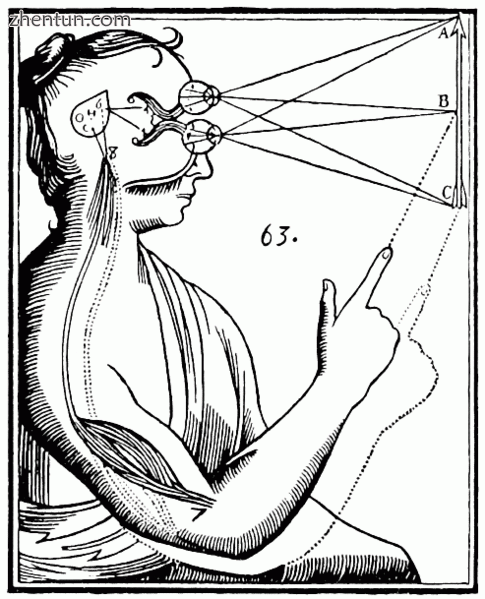
“人类论”中笛卡尔松果体的运作图(图1664年出版)
十七世纪的哲学家和科学家RenéDescartes对解剖学和生理学非常感兴趣。他在他的第一本书“人类的论文”(1637年之前写的,但只是在1662/1664年后出版)和他的最后一本书“灵魂的激情”(1649年)中讨论了松果腺,并将其视为“灵魂的主要位置和我们所有思想形成的地方。“[56]在”人类论“中,笛卡尔描述了人的概念模型,即由上帝创造的生物,它由两个成分组成,一个身体和一个灵魂[56]。[57]在激情中,笛卡尔将人分成一个身体和一个灵魂,并强调灵魂通过“位于大脑物质中间的某个非常小的腺体并且悬浮在精神通过的通道之上而与整个身体相连。大脑的前腔与其后腔中的那些通信“。笛卡尔对腺体具有重要意义,因为他认为它是大脑中唯一存在于单个部分而不是一对中的部分。大多数笛卡尔的基本解剖学和生理学假设都是完全错误的,不仅是现代标准,还有他当时已知的事情。[56] [58]
“松果之眼”的概念是法国作家乔治巴塔耶哲学的核心,文学学者丹尼斯霍利尔在他的反建筑研究中对其进行了长篇分析。在这项工作中,霍利尔讨论了巴塔耶如何使用“松果眼”的概念作为西方理性盲点的参考,以及过度和谵妄的器官。[59]这个概念设备在他的超现实主义文本,耶稣和松果之眼中是明确的。[60]
在19世纪后期,Blavatsky夫人(他创立了神智学)用第三只眼的印度教概念或者Ajna脉轮来识别松果腺。这种联系今天仍然很受欢迎。[56]
Rick Strassman是新墨西哥大学医学院精神病学的作者和临床副教授,他推测人类松果体在某些情况下能够产生迷幻剂N,N-二甲基色胺(DMT)。[61] 2013年,他和其他研究人员首次报道了啮齿类动物松果体微透析液中的DMT [62]。
在HP Lovecraft的短篇小说“From Beyond”中,科学家创造了一种发出共振波的电子设备,它可以刺激受影响人的松果腺,从而使她或他能够感知存在于已接受现实范围之外的存在平面,半透明的,外在的环境,与我们自己公认的现实重叠。它于1986年被改编为同名电影。2013年的恐怖电影“Banshee Chapter”深受此短篇小说的影响。
历史
松果体的分泌活动仅部分被理解。它在大脑深处的位置向历史上的哲学家们提出它具有特别的重要性。这种结合使其被视为一个神秘的,形而上学的,神秘的理论围绕其感知功能的“神秘”腺体。
最初认为松果腺是较大器官的“退化残余”。 1917年,人们知道牛松果的提取物可以减轻青蛙的皮肤。耶鲁大学的皮肤病学教授Aaron B. Lerner及其同事希望松果体中的一种物质可用于治疗皮肤病,并于1958年将激素褪黑激素分离并命名。[63]这种物质没有被证明是有用的,但它的发现帮助解决了一些谜团,例如为什么去除大鼠的松果体加速卵巢生长,为什么让老鼠保持恒定的光线会减轻松果体的重量,以及为什么松果体切除术和持续光照会影响卵巢同等增长;这些知识推动了当时新的时间生物学领域的发展。[64]
另见
Pineal gland cyst
Additional images
The pineal body is labeled in these images.
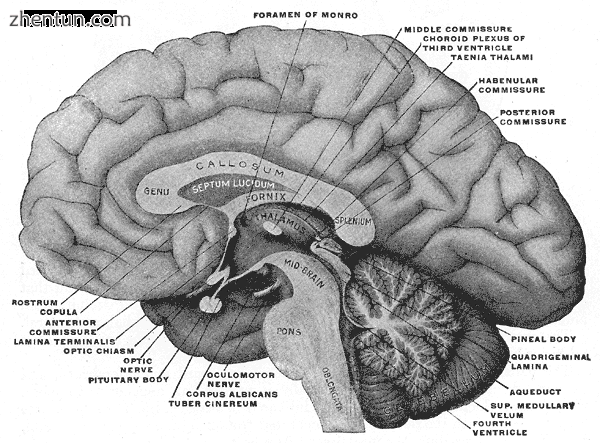
在正中矢状面切片的大脑的近中面。
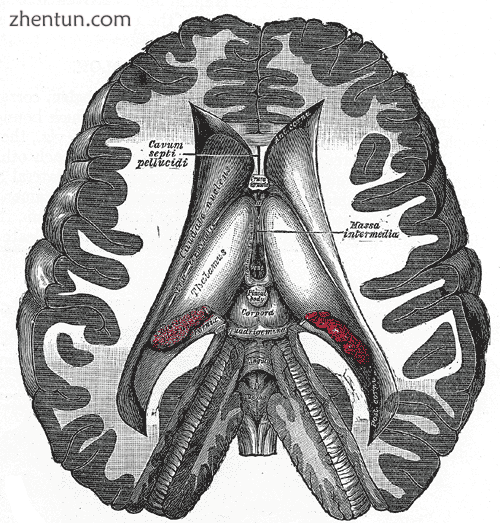
解剖显示大脑的脑室。
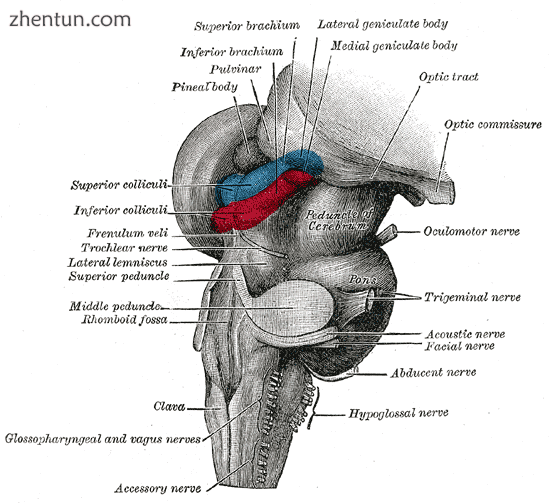
后脑和中脑; 前视图。
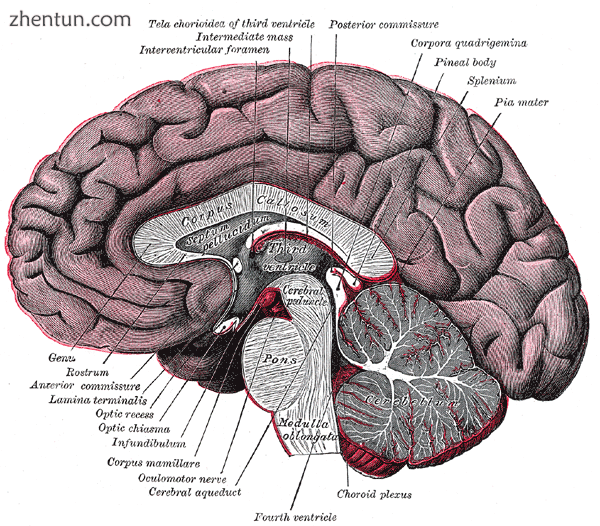
大脑正中矢状切面。
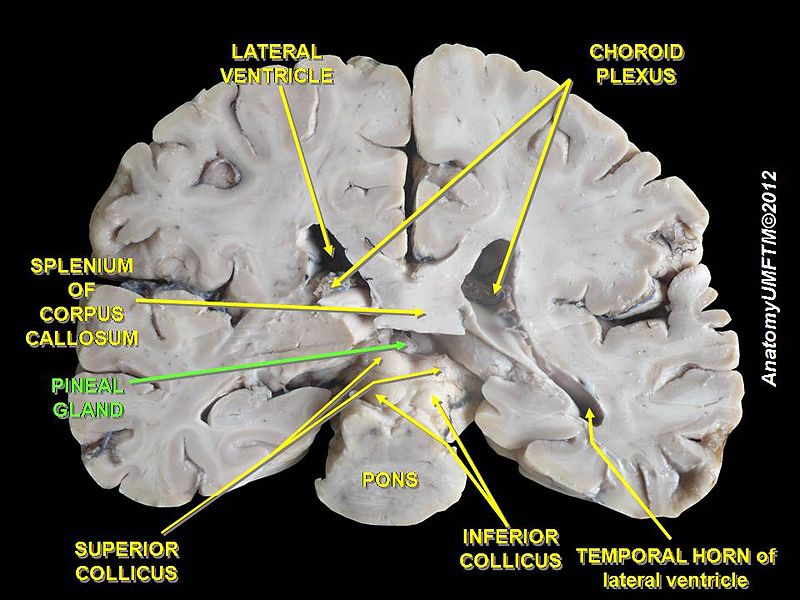
松果体
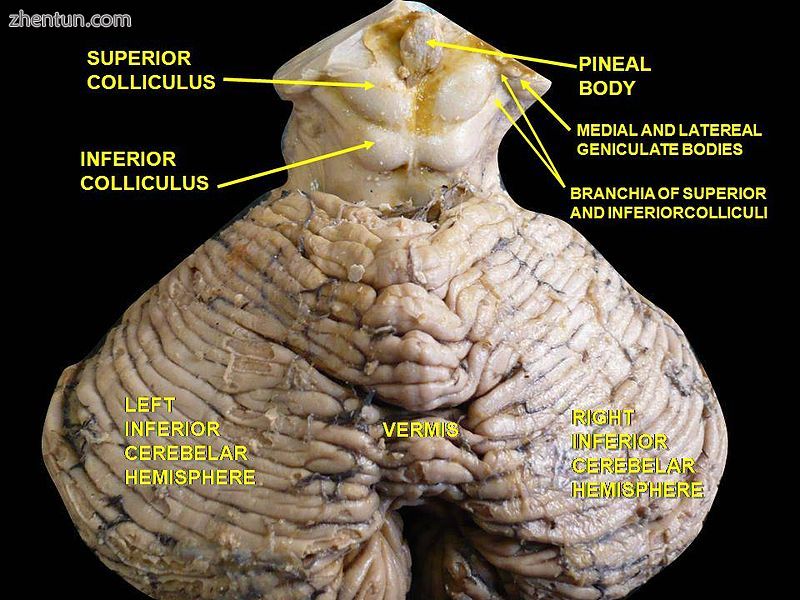
脑干。后视图。
参考
"Pineal (as an adjective)". Online Etymology Dictionary, Douglas Harper. 2018. Retrieved 27 October 2018.
Macchi MM, Bruce JN (2004). "Human pineal physiology and functional significance of melatonin". Front Neuroendocrinol. 25 (3–4): 177–95. doi:10.1016/j.yfrne.2004.08.001. PMID 15589268.
Arendt J, Skene DJ (2005). "Melatonin as a chronobiotic". Sleep Med Rev. 9 (1): 25–39. doi:10.1016/j.smrv.2004.05.002. PMID 15649736. Exogenous melatonin has acute sleepiness-inducing and temperature-lowering effects during 'biological daytime', and when suitably timed (it is most effective around dusk and dawn) it will shift the phase of the human circadian clock (sleep, endogenous melatonin, cortisol) to earlier (advance phase shift) or later (delay phase shift) times.
Gross PM, Weindl A (December 1987). "Peering through the windows of the brain". J. Cereb. Blood Flow Metab. 7 (6): 663–72. doi:10.1038/jcbfm.1987.120. PMID 2891718.
Ooka-Souda S, Kadota T, Kabasawa H (December 1993). "The preoptic nucleus: the probable location of the circadian pacemaker of the hagfish, Eptatretus burgeri". Neurosci. Lett. 164 (1–2): 33–6. doi:10.1016/0304-3940(93)90850-K. PMID 8152610.
Vernadakis AJ, Bemis WE, Bittman EL (April 1998). "Localization and partial characterization of melatonin receptors in amphioxus, hagfish, lamprey, and skate". Gen. Comp. Endocrinol. 110 (1): 67–78. doi:10.1006/gcen.1997.7042. PMID 9514841.
Erlich SS, Apuzzo ML (September 1985). "The pineal gland: anatomy, physiology, and clinical significance". J. Neurosurg. 63 (3): 321–41. doi:10.3171/jns.1985.63.3.0321. PMID 2862230.
Eakin, Richard M. (1973). The Third Eye. Berkeley: University of California Press.
Bowen, R. "The Pineal Gland and Melatonin". Archived from the original on 24 November 2011. Retrieved 14 October 2011.
http://www.ajnr.org/content/19/9/1631.full.pdf
Dorland's. Illustrated Medical Dictionary. Elsevier Saunders. p. 1607. ISBN 978-1-4160-6257-8.
Pritchard, Thomas C.; Alloway, Kevin Douglas (1999). Medical Neuroscience (Google books preview). Hayes Barton Press. pp. 76–77. ISBN 978-1-889325-29-3. Retrieved 8 February 2009.
Arendt J: Melatonin and the Mammalian Pineal Gland, ed 1. London. Chapman & Hall, 1995, p 17
Møller M, Baeres FM (July 2002). "The anatomy and innervation of the mammalian pineal gland". Cell Tissue Res. 309 (1): 139–50. doi:10.1007/s00441-002-0580-5. PMID 12111544.
Kleinschmidt-DeMasters BK, Prayson RA (November 2006). "An algorithmic approach to the brain biopsy--part I". Arch. Pathol. Lab. Med. 130 (11): 1630–8. doi:10.1043/1543-2165(2006)130[1630:AAATTB]2.0.CO;2 (inactive 6 September 2018). PMID 17076524.
Schmidt F, Penka B, Trauner M, Reinsperger L, Ranner G, Ebner F, Waldhauser F (April 1995). "Lack of pineal growth during childhood". J. Clin. Endocrinol. Metab. 80 (4): 1221–5. doi:10.1210/jcem.80.4.7536203. PMID 7536203.
Sumida M, Barkovich AJ, Newton TH (February 1996). "Development of the pineal gland: measurement with MR". AJNR Am J Neuroradiol. 17 (2): 233–6. PMID 8938291.
Tapp E, Huxley M (September 1971). "The weight and degree of calcification of the pineal gland". J. Pathol. 105 (1): 31–9. doi:10.1002/path.1711050105. PMID 4943068.
Tapp E, Huxley M (October 1972). "The histological appearance of the human pineal gland from puberty to old age". J. Pathol. 108 (2): 137–44. doi:10.1002/path.1711080207. PMID 4647506.
"Melatonin Production and Age". Chronobiology. Medichron Publications.
Snelson, CD; Santhakumar, K; Halpern, ME; Gamse, JT (May 2008). "Tbx2b is required for the development of the parapineal organ". Development. 135 (9): 1693–702. doi:10.1242/dev.016576. PMC 2810831. PMID 18385257.
Snelson, CD; Burkart, JT; Gamse, JT (December 2008). "Formation of the asymmetric pineal complex in zebrafish requires two independently acting transcription factors". Developmental Dynamics. 237 (12): 3538–44. doi:10.1002/dvdy.21607. PMC 2810829. PMID 18629869.
Snelson, Corey D.; Gamse, Joshua T. (June 2009). "Building an asymmetric brain: Development of the zebrafish epithalamus". Seminars in Cell & Developmental Biology. 20 (4): 491–497. doi:10.1016/j.semcdb.2008.11.008. PMC 2729063. PMID 19084075.
Axelrod J (1970). "The pineal gland". Endeavour. 29 (108): 144–8. PMID 4195878.
Lowrey, Phillip L.; Takahashi, Joseph S. (2000). "Genetics of the Mammalian Circadian System: Photic Entrainment, Circadian Pacemaker Mechanisms, and Posttranslational Regulation". Annual Review of Genetics. 34 (1): 533–562. doi:10.1146/annurev.genet.34.1.533. PMID 11092838.
Callaway, James C.; Gyntber, Jukka; Poso, Antti; Airaksinen, Mauno M.; Vepsäläinen, Jouko (1994). "The pictet-spengler reaction and biogenic tryptamines: Formation of tetrahydro-β-carbolines at physiologicalpH". Journal of Heterocyclic Chemistry. 31 (2): 431–435. doi:10.1002/jhet.5570310231.
Motta, Marina; Fraschini, F.; Martini, L. (1967). "Endocrine Effects of Pineal Gland and of Melatonin". Exp Biol Med (Maywood). 126 (2): 431–435. doi:10.3181/00379727-126-32468.
Naidoo, V; Naidoo, S; Mahabeer, R; Raidoo, DM (2004). "Cellular distribution of the endothelin system in the human brain". Journal of Chemical Neuroanatomy. 27 (2): 87–98. doi:10.1016/j.jchemneu.2003.12.002. PMID 15121213.
Gross, PM; Wainman, DS; Chew, BH; Espinosa, FJ; Weaver, DF (1993). "Calcium-mediated metabolic stimulation of neuroendocrine structures by intraventricular endothelin-1 in conscious rats". Brain Research. 606 (1): 135–42. PMID 8461995.
Uz T, Akhisaroglu M, Ahmed R, Manev H (December 2003). "The pineal gland is critical for circadian Period1 expression in the striatum and for circadian cocaine sensitization in mice". Neuropsychopharmacology. 28 (12): 2117–23. doi:10.1038/sj.npp.1300254. PMID 12865893.
Uz T, Dimitrijevic N, Akhisaroglu M, Imbesi M, Kurtuncu M, Manev H (2004). "The pineal gland and anxiogenic-like action of fluoxetine in mice". NeuroReport. 15 (4): 691–4. doi:10.1097/00001756-200403220-00023. PMID 15094477.
Manev H, Uz T, Kharlamov A, Joo JY (November 1996). "Increased brain damage after stroke or excitotoxic seizures in melatonin-deficient rats". FASEB J. 10 (13): 1546–51. PMID 8940301.
Sharan K, Lewis K, Furukawa T, Yadav VK (September 2017). "Regulation of bone mass through pineal-derived melatonin-MT2 receptor pathway". J. Pineal Res. 63 (2). doi:10.1111/jpi.12423. PMC 5575491. PMID 28512916.
Zimmerman, Robert A. "Age-Related Incidence of Pineal Calcification Detected by Computed Tomography" (PDF). Radiological Society of North America. Archived (PDF) from the original on 24 March 2012. Retrieved 21 June 2012.
"The Pineal Body". Human Anatomy (Gray's Anatomy). Archived from the original on 26 August 2011. Retrieved 7 September 2011.
Kumar, Vinay; Abbas, Abul K; Aster, Jon C (5 September 2014). Robbins & Cotran Pathologic Basis of Disease. p. 1137. ISBN 9780323296359.
Bruce, Jeffrey. "Pineal Tumours". eMedicine. Archived from the original on 5 September 2015. Retrieved 25 September 2015.
"Pineal Tumours". American Brain Tumour Association. Archived from the original on 26 September 2015. Retrieved 25 September 2015.
Clark AJ, Sughrue ME, Ivan ME, Aranda D, Rutkowski MJ, Kane AJ, Chang S, Parsa AT (November 2010). "Factors influencing overall survival rates for patients with pineocytoma". J. Neurooncol. 100 (2): 255–60. doi:10.1007/s11060-010-0189-6. PMC 2995321. PMID 20461445.
Cole WC, Youson JH (October 1982). "Morphology of the pineal complex of the anadromous sea lamprey, Petromyzon marinus L". Am. J. Anat. 165 (2): 131–63. doi:10.1002/aja.1001650205. PMID 7148728.
Cope, Edward Drinker (1888). "The pineal eye in extinct vertebrates". American Naturalist. 22 (262): 914–917. doi:10.1086/274797.
Schultze, Hans-Peter (1993). "Patterns of diversity in the skulls of jawed fishes". In Hanken, James; Hall, Brian K. (eds.). The Skull, Volume 2: Patterns of Structural and Systematic Diversity. Chicago, Illinois: University of Chicago Press. pp. 189–254. ISBN 9780226315683. Retrieved 2 February 2017.
Dodt, Eberhard (1973). "The parietal eye (pineal and parietal organs) of lower vertebrates". Visual Centers in the Brain. Springer. pp. 113–140.
Tosini, Gianluca (1997). "The pineal complex of reptiles: physiological and behavioral roles". Ethology Ecology & Evolution. 9 (4): 313–333. doi:10.1080/08927014.1997.9522875.
Dendy, A. (1911). "On the structure, development and morphological interpretation of the pineal organs and adjacent parts of the brain in the tuatara (Sphenodon punctatus)". Philosophical Transactions of the Royal Society of London B. 201 (274–281): 227–331. doi:10.1098/rstb.1911.0006.
Quay, WB (1979). "The parietal eye–pineal complex". In Gans, Carl; Northcutt, R. Glenn; Ulinski, Philip (eds.). Biology of the Reptilia. Volume 9. Neurology A. London: Academic Press. pp. 245–406. Archived from the original on 3 February 2017.
Vollrath, L. (1979). Comparative morphology of the vertebrate pineal complex. Progress in Brain Research. 52. pp. 25–38. doi:10.1016/S0079-6123(08)62909-X. ISBN 9780444801142. PMID 398532.
Ralph, Charles (1975). "The pineal gland and geographical distribution of animals". International Journal of Biometeorology. 19 (4): 289–303. Bibcode:1975IJBm...19..289R. doi:10.1007/bf01451040. PMID 1232070.
Ralph, Charles; Young, S; Gettinger, R; O'Shea, TJ (1985). "Does the manatee have a pineal body?". Acta Zoologica. 66: 55–60. doi:10.1111/j.1463-6395.1985.tb00647.x.
Adler, Kraig (1976). "Extraocular photoreception in amphibians". Photochemistry and Photobiology. 23 (4): 275–298. doi:10.1111/j.1751-1097.1976.tb07250.x.
Klein DC (August 2004). "The 2004 Aschoff/Pittendrigh lecture: Theory of the origin of the pineal gland--a tale of conflict and resolution". J. Biol. Rhythms. 19 (4): 264–79. doi:10.1177/0748730404267340. PMID 15245646.
Natesan A, Geetha L, Zatz M (July 2002). "Rhythm and soul in the avian pineal". Cell Tissue Res. 309 (1): 35–45. doi:10.1007/s00441-002-0571-6. PMID 12111535.
Moore RY, Heller A, Wurtman RJ, Axelrod J (January 1967). "Visual pathway mediating pineal response to environmental light". Science. 155 (3759): 220–3. Bibcode:1967Sci...155..220M. doi:10.1126/science.155.3759.220. PMID 6015532.
Edinger, Tilly (1955). "The size of parietal foramen and organ in reptiles: a rectification". Bulletin of the Museum of Comparative Zoology. 114: 1–34. Archived from the original on 1 December 2017.
Kurochkin EN, Dyke GJ, Saveliev SV, Pervushov EM, Popov EV (June 2007). "A fossil brain from the Cretaceous of European Russia and avian sensory evolution". Biol. Lett. 3 (3): 309–13. doi:10.1098/rsbl.2006.0617. PMC 2390680. PMID 17426009.
Lokhorst, Gert-Jan (2015). Descartes and the Pineal Gland. Stanford: The Stanford Encyclopedia of Philosophy.
Descartes R. "The Passions of the Soul" excerpted from "Philosophy of the Mind," Chalmers, D. New York: Oxford University Press, Inc.; 2002. ISBN 978-0-19-514581-6
Wikisource:Ethics (Spinoza)/Part 5
Hollier, D, Against Architecture: The Writings of Georges Bataille, trans. Betsy Wing, MIT, 1989.
Bataille, G, Visions of Excess: Selected Writings, 1927–1939 (Theory and History of Literature, Vol 14), trans. Allan Stoekl et al., Manchester University Press, 1985
Strassman, Rick (2000). DMT: The Spirit Molecule. Inner Traditions. ISBN 978-1594779732. Archived from the original on 6 January 2017.
Barker SA, Borjigin J, Lomnicka I, Strassman R (July 2013). "LC/MS/MS analysis of the endogenous dimethyltryptamine hallucinogens, their precursors, and major metabolites in rat pineal gland microdialysate" (PDF). Biomed Chromatogr. 27 (12): 1690–1700. doi:10.1002/bmc.2981. PMID 23881860.
Lerner AB, Case JD, Takahashi Y (July 1960). "Isolation of melatonin and 5-methoxyindole-3-acetic acid from bovine pineal glands". J. Biol. Chem. 235: 1992–7. PMID 14415935.
Coates, Paul M. (2005). Encyclopedia of Dietary Supplements. Marc R. Blackman, Gordon M. Cragg, Mark Levine, Joel Moss, Jeffrey D. White. CRC Press. p. 457. ISBN 978-0-8247-5504-1. Retrieved 31 March 2009. |